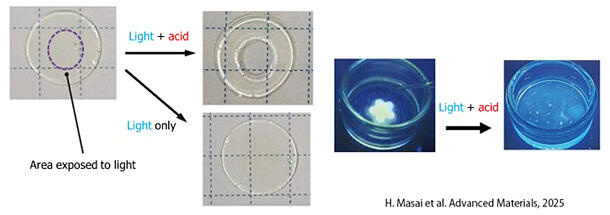In recent years, there has been a growing interest in technologies that decompose polymeric materials, such as plastics. In particular, a method that uses light to decompose materials is widely utilized in industry. However, photodegradable materials quickly decompose when exposed to continuous light, making them unsuitable for long-term use. Hence, such materials can only be used in places without sunlight or fluorescent light, limiting their application scope.
A research team led by Associate Professor Hiroshi Masai of the Graduate School of Engineering at the University of Tokyo, successfully developed a polymer material. The developed polymer material can freely switch between photostability and photodegradability depending on the presence or absence of an acid. The research team previously developed similar materials, but these required platinum compounds, which are very expensive precious metals, and thus encountered problems such as high cost and poor photostability.
To solve these problems, they developed a "dipyrenyl silicon compound" that uses inexpensive silicon. This compound not only exhibits higher photostability than previously reported materials but also demonstrates that light and acid function together to decompose materials with high efficiency. The researchers confirmed that when applied as a gel, the new material was stable even after long-term exposure to light. However, it rapidly decomposed when exposed to light in the presence of an acid. Furthermore, it can be used as a photofunctional material that emits light when exposed to black light or as a photo-molding 3D printing material that can be molded using light.
In this work, the researchers successfully synthesized a new material that can be decomposed via exposures to light and acid using inexpensive silicon, which is abundant on Earth. This result, i.e., combining two contradictory properties of a material, namely degradability and stability, is expected to contribute to innovation in material photocontrol technology.
Examples of introducing dipyrenyl silicon compounds into materials

The feasibility of applying the developed compound to luminescent materials was also confirmed (right).




